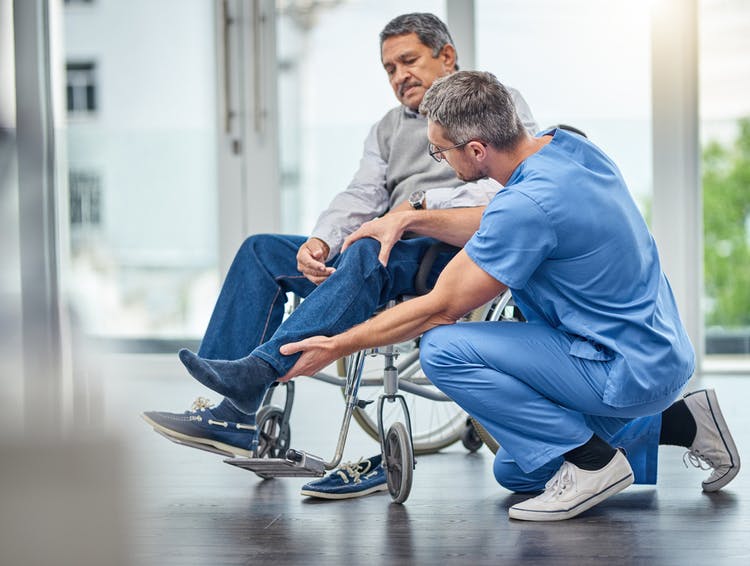Pain after spinal cord injury is common, affecting up to 80% of SCI patients. Normally, sensations travel from the body, through the spinal cord, and to the brain for processing. However, a spinal cord injury can disrupt the flow of messages between the brain and body, which can cause the brain to misinterpret these messages as pain. Pain can also be the result of secondary complications of SCI, such as shoulder pain from wheelchair use or bladder problems.
This article will go over 3 types of pain that can occur after spinal cord injury and effective ways to manage them.
Types of Pain after Spinal Cord Injury
Several different types of pain can occur after a spinal cord injury. Every spinal cord injury is unique, so everyone will experience pain differently. Pain can range from mild to severe and occur occasionally or constantly.
It’s essential for patients to understand the symptoms of their specific type(s) of pain. In doing so, they are able to communicate and discuss them with a healthcare provider who can offer effective treatments.
In this section, we’ll discuss 3 of the most commonly reported types of pain after spinal cord injury.
Musculoskeletal Pain
Musculoskeletal pain can be caused by muscle tightness or from excessive use of the bones, muscles, or joints. It is often described as, “dull and consistent but bearable.”
This type of pain can be attributed to poor posture, which pulls the muscles and strains the joints. Also, after an SCI, patients may become more dependent on the unaffected parts of their bodies. Because these muscles may not be accustomed to doing so much work, musculoskeletal pain may develop.
For example, someone with paralysis in their legs will have to learn to rely upon their shoulders and arms to move around in a wheelchair. Consequently, the patient may experience pain in the shoulders, elbows, wrists, and forearms as a result of overuse.
It’s interesting to note that musculoskeletal pain is typically felt above the injury site, where sensation is not affected.
Visceral Pain

Visceral pain refers to pain from internal organs. Although it’s the least common of the 3 types of pain, it can be the most long-lasting.
This type of pain generally occurs around the abdomen in the form of aching or cramping. Visceral pain is often associated with complications involving the urinary tract or bowel.
Many patients with spinal cord injury have difficulties controlling their bowel and bladder muscles, which can cause constipation, urinary tract infections, and kidney damage. Therefore, it makes sense that visceral pain often occurs after SCI.
Neuropathic Pain
Unlike musculoskeletal and visceral pain, neuropathic pain is directly caused by damage to the central nervous system.
Generally, neuropathic pain occurs because damage to the spinal cord disrupts the transmission of sensory signals to the brain. As a result, the brain misinterprets the sensory signals and perceives them as pain.
Neuropathic pain after spinal cord injury is often described as “sharp, stabbing, or burning” pain that can be felt below the level of injury, even in areas where individuals have completely lost sensation.
In fact, feeling pain below one’s level of injury can be a good sign of recovery because it indicates that neural pathways between the brain and body still exist.
Now that you understand the 3 types of pain that can occur after a spinal cord injury, let’s discuss how to manage them.
How to Manage Pain After Spinal Cord Injury
Pain management after spinal cord injury should be tailored to each individual’s unique symptoms. Some people experience severe pain that requires stronger treatments, while others have mild pain that can be managed with simpler interventions. Generally, the more powerful the treatment, the higher the risk of adverse side effects.
Common management interventions for pain after spinal cord injury include:
1. Medications

Medications for chronic pain after spinal cord injury can vary significantly depending on the severity of pain.
Commonly used medications for pain include:
- Non-steroidal anti-inflammatory drugs (NSAIDs)
- Muscle relaxants
- Topical numbing creams
- Opioids
- Antidepressants
- Anticonvulsants
While medications can be extremely helpful, they generally will not address the source of pain. As a result, pain reduction is often temporary, and medications may not be ideal for long-term relief.
2. Physical Therapy
Physical therapy can help reduce pain after spinal cord injury by lengthening tight muscles, strengthening underused muscles, and promoting full range of motion in the joints. By continuously practicing exercises, spinal cord injury patients can stimulate neuroplasticity.
Neuroplasticity is the spinal cord’s ability to rewire itself, which enables muscles affected by SCI to be strengthened and improved. By promoting neuroplasticity through repetitive movement, SCI patients can reduce the excitability of spastic muscles and minimize pain long-term.
3. Botox Injections
Botox injections can be an effective way to relieve localized pain that is caused by spasticity. Rather than taking an oral medication that will affect the entire body, Botox is injected directly into the painful muscle. It works by blocking transmitters that cause muscle contractions.
Like other medications, the effects of Botox are temporary and typically last between 3-6 months. To promote long-term pain relief, SCI patients should take advantage of their reduced spasticity and focus on promoting neurological adaptions through intensive physical therapy.
4. Electrical Stimulation
While it is now being used to promote movement after spinal cord injury, electrical stimulation was initially used to treat chronic pain. Electric currents can block pain signals and stimulate the production of endorphins so that the brain perceives less pain. Invasive and non-invasive forms of electrical stimulation exist; however, invasive methods provide more precise and effective pain relief.
5. Rest
Individuals with musculoskeletal pain can often relieve pain by simply giving their muscles a break. By reducing the amount of strain on the muscles, tissues can repair themselves and become less sensitive to pain.
6. Orthotic Devices
Patients experiencing musculoskeletal pain from poor posture may benefit from wearing orthotic devices such as braces, splints, and casts. These promote proper alignment to reduce unnecessary strain on the joints and reduce the chance for injury or dislocation.
7. Alternative Remedies
Alternative therapies like acupuncture and massage can also effectively reduce pain after spinal cord injury. Acupuncture is a traditional Chinese therapy that involves placing thin, hair-like needles onto the skin to stimulate the nerves and promote circulation. Massage therapy helps relax tight muscles and promote circulation.
Because alternative treatments lack standardization, their therapeutic benefits appear to be hit-or-miss among patients with SCI. Regardless, they’re worth trying because they have very minimal risk of side effects and are relatively affordable in comparison to pharmaceuticals.
Understanding Pain After Spinal Cord Injury
Living with chronic pain after spinal cord injury can interfere with daily activities, sleep, and relationships. It’s also possible to experience multiple types of pain at the same time. Luckily, there are effective ways to minimize pain so that individuals can focus on recovery.
Everyone experiences pain after SCI differently, so treatments will vary from person-to-person. Hopefully, this article helped you better understand the different types of pain that can occur after SCI and how to manage them.











